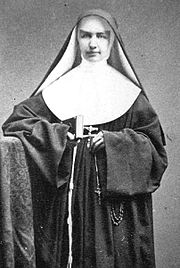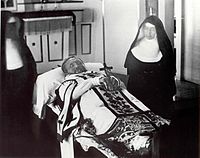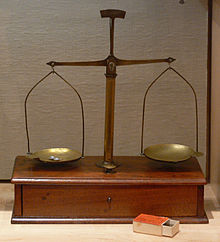- Marianne Cope
-
Blessed Marianne Cope, O.S.F. 
Virgin, Religious Sister, missionary to leprosy patientsBlessed Born January 23, 1838
Heppenheim, Grand Duchy of HesseDied August 9, 1918 (aged 80)
Kalaupapa, Hawaiʻi, United StatesHonored in Sisters of St. Francis, Roman Catholic Church, Episcopal Church (USA) Beatified May 14, 2005, Saint Peter's Basilica, Vatican City by Pope Benedict XVI Major shrine Shrine & Museum of Blessed Marianne Cope
Sisters of Saint Francis MotherhouseFeast January 23 (R.C.C.), April 15 (EC USA) Patronage people with leprosy, outcasts, those with HIV/AIDS, the Hawaiʻi. The Blessed Marianne Cope, O.S.F., christened Maria Anna Barbara Koob (later changed to "Cope") (1838–1918), was a member of the Sisters of St. Francis of Syracuse, a religious congregation of the Roman Catholic Church. Born in Heppenheim (Germany) and entered religious life in Syracuse, New York, she spent many years in heroic service to the lepers on the island of Molokaʻi in Hawaiʻi. Despite close contact with the patients over many years, she was not herself afflicted by the disease, considered by some to be miraculous.
Mother Marianne was among the first group of people beatified by Pope Benedict XVI [1] and is now often referred to as Blessed Marianne of Molokaʻi. Her feast day is observed on January 23, celebrated by her Congregation, the Diocese of Honolulu and the Diocese of Syracuse.
Contents
Life
Birth and vocation
Maria Anna Barbara Koob was born January 23, 1838 in Heppenheim in the Grand Duchy of Hesse (modern-day Germany) to Peter Koob (1787-1862) and Barbara Witzenbacher Koob (1803-1872). That following year her family emigrated to the United States, settling in Utica, New York. There they became members of the Parish of St. Joseph, where she attended the parish school. By the time she had completed the eighth grade, her father had become an invalid. As the oldest child in the house, she became a factory worker to help support the family. [2] Around that time, her father became an American citizen, which, at the time, gave citizenship status to the whole family.
After her father's death during the summer of 1862, when she was twenty-four, she felt free enough of her family responsibilities to follow a religious vocation she had long felt. She entered the novitiate of the Sisters of the Third Order Regular of Saint Francis based in Syracuse, New York. At the completion of her year of formation, she received the religious habit of the Franciscan Sisters, at which time she was given the name Marianne. The new Sister Marianne then went on to spend nearly a decade, first as a teacher and then a principal, in newly-established schools for German-speaking immigrants in the region.
By 1870, she was a member of the governing Council of her congregation. In this office, she was involved in the opening of the first two Catholic hospitals in Central New York. They were unusual in their Charter for the time in that it was stipulated that medical care was to be provided to all, regardless of race or creed. She was appointed by the Superior General to direct St. Joseph’s Hospital, the first public hospital in Syracuse, which she did from 1870-1877.
During her period of hospital administration, she became involved with the move of the College of Medicine in Geneva, New York to Syracuse, where it became the Geneva Medical College. She contracted with the college to accept their students in the treatment of the hospital's patients, to further their medical education. Her stipulation in the contract--again unique for the period--was the right of the patients to refuse care by the students. These experiences helped prepare her for the special ministry that lay ahead of her.[3]
Call to Hawaii
In 1883, Mother Marianne, by then herself Superior General of the congregation, received a plea for help in caring for leprosy sufferers from King Kalākaua of Hawaii. She responded to the letter enthusiastically:
I am hungry for the work and I wish with all my heart to be one of the chosen Ones, whose privilege it will be, to sacrifice themselves for the salvation of the souls of the poor Islanders... I am not afraid of any disease, hence it would be my greatest delight even to minister to the abandoned ‘lepers.’[4]
Mother Marianne set out with six of her Sisters from Syracuse to travel to Honolulu to answer this call, arriving on November 8, 1883. The bells of Our Lady of Peace Cathedral pealed to welcome their ship, the SS Mariposa, as it entered Honolulu harbor. With Mother Marianne as supervisor, the Sisters' task was to manage Kakaʻako Branch Hospital on Oʻahu, which served as a receiving station for Hansen's disease patients gathered from all over the islands. Here the more severe cases were processed and shipped to the island of Molokaʻi for confinement in the settlement at Kalawao, and then later at Kalaupapa.
The following year, at the request of the government, she set up Malulani Hospital, the first General Hospital on the island of Maui. Soon, however, she was called back with haste to the hospital in Oahu, where she had to deal with a government-appointed administrator’s abuse of the leprosy patients at the Branch Hospital at Kakaako, an area adjoining Honolulu. Her demand to the government to choose between his dismissal or the Sisters’ return to Syracuse resulted in her being given full charge of the overcrowded hospital. Her own expected return to Syracuse to re-assume governance of the Congregation was then delayed when her leadership was declared by both government and church authorities to be essential to the success of the Mission.
Two years after the arrival of the Sisters, her accomplishments had so stirred the admiration of the Hawaiian government that the King himself bestowed on Mother Marianne the Cross of a Companion of the Royal Order of Kapiolani for her acts of benevolence to his suffering people.[5]
Yet the work kept increasing. Another pressing need was fulfilled when a year later, in November 1885, after Mother Marianne had convinced the government that it was of vital need to save the homeless female children of leprosy patients, the Kapiolani Home was opened. The unusual choice of location for healthy children to dwell in a Home situated on the grounds of a leprosy hospital was made because no one other than the Sisters could be found to care for those so closely associated with people with the dreaded disease.
A new government took over in 1887, which changed the official policy toward leprosy patients. While new patients had not been forced into exile at Molokai for several years, the new administration decided to end that policy, and closed the hospital built for them in Oahu. A year later, as the consequences of this decision became clear, the authorities pleaded with Mother Marianne to establish a new Home for women and girls on the Kalaupapa peninsula of Molokai. Though this step meant that she would likely never be able to return to New York and see her family and friends again, Marianne accepted the call. “We will cheerfully accept the work…" was her response.[6]
Molokai
In November 1888, she moved to Kalaupapa both to care for the ailing Blessed Damien of Molokaʻi, SS.CC., and to assume his burdens. She had met him shortly after her arrival in Hawaii, when, while still in good health, Father Damien had gone to Oahu to attend the dedication of the chapel in the hospital she was establishing. After his diagnosis as a leper, he was shunned by both civil and church leaders. It was only Mother Marianne who gave him welcome, even arranging for the King to meet him.
When the holy priest died five months later, on April 15th, the government officially gave Mother Marianne charge for the care of the boys of Kalaupapa, as well as her original commission for the female residents of the colony. A prominent local businessman, Henry P. Baldwin, had donated money for the new Home; Mother Marianne and two assistants, Sister Leopoldina Burns and Sister Vincentia McCormick, opened and ran a new Girls School, which she named in his honor. At her suggestion, a community of lay Brothers was invited to come and care for the boys. After the arrival of four Brothers of the Sacred Heart in 1895[7], she withdrew the Sisters to the Bishops School for Girls and "Brother" Charles Dutton was given charge of the Baldwin House by the government. (He was a veteran of the American Civil War who had left behind in the United States a life broken by alcoholism, and it was he who had been Blessed Damien's primary assistant.)
Mother Marianne died August 9, 1918, of natural causes and was buried at the Bishop Home.[8]
Legacy
- In 1927, Saint Francis Hospital was founded in Honolulu in her memory as a community hospital and to train nurses to work with Hansen's disease patients.
- In 1957, St. Francis opened the Child Development Center at the Community Church in Honolulu, for preschool-aged children who weren’t mentally challenged but demonstrated emotional problems.
- In 1962, understanding that people recover faster in the comfort of their own homes surrounded by loved ones, St. Francis Home Care Services was established, the first in Hawaii to specialize in home health care, the first of many services introduced for the care of the Hawaiian people.
- In 2006, the Sisters of St. Francis chose to divest themselves of acute care facilities and to focus on long term care.
- In 2007, the two facilities which had developed from St. Francis Medical Center East & West are handed over to a private board and soon become known as the Hawaiian Medical Center East and Hawaiian Medical Center West.[9]
Additionally, the Saint Francis School was founded in 1924, which is a school for girls in grades 6-9. was founded in her honor[10] At Kalaupapa the Sisters still maintain the continuity of their comforting presence to the very few Hansen Disease patients living there today. Franciscan Sisters work at several schools and minister to parishioners in the islands.
Beatification
On October 24, 2003, theologians at the Congregation for the Causes of Saints declared her heroically virtuous. On April 19, 2004, Pope John Paul II issued the decree officially naming her Venerable.
In 1993 Katherine Dehlia Mahoney had recovered from multiple organ failure after prayers were said to Mother Marianne for her recovery. On December 20, 2004, after receiving the unanimous affirmation of the Congregation, Pope John Paul II ordered a decree to be issued authenticating this recovery as a miracle to be attributed to Mother Marianne’s intercession. On May 14, 2005, Venerable Marianne was beatified by Pope Benedict XVI in his first such ceremony as pope in Vatican City. Her cause is awaiting further affirmation.
Over one hundred followers from Hawaiʻi attended the beatification ceremony. Three hundred followers from the Blessed Mother's religious Congregation in Syracuse were also in attendance. During the ceremony presided over by Cardinal José Saraiva Martins, C.M.F., the Hawaiian song Makalapua was sung. This song was a favorite of Mother Marianne.[11]
Veneration
After the announcement by the Holy See of her impending beatification, Venerable Marianne's remains were moved during January 2005 from there to the Motherhouse of the Congregation in Syracuse . A temporary shrine was established to honor her. On January 23, 2009, the erection of a marble sarcophagus in the Chapel of the Sisters was complete, and the remains were permanently moved one last time to where she was finally laid to rest. This now serves as her primary shrine.[12]
In 2007 a statue was erected at St. Joseph's Church in Utica, which she had attended in her childhood and where she had received her education.[13]
Additionally, Blessed Marianne is honored together with Blessed Damien with a feast day on the liturgical calendar of the Episcopal Church (USA) on April 15.
See also
- American Catholic Saints
- List of American saints and beatified people
References
- ^ Pope Benedict XVI (May 14, 2005). "Apostolic Letter by which the Supreme Pontiff has raised to the glory of the altars the Servants of God: Ascensión Nicol Goñi and Marianne Cope". The Holy See. http://www.vatican.va/holy_father/benedict_xvi/apost_letters/documents/hf_ben-xvi_apl_20050514_beatifications-goni-cope_lt.html. Retrieved 2010-03-19. (Latin)
- ^ Krista J. Karch (May 11, 2005). "The road to sainthood: Mother Marianne worked years in Utica mills before joining convent". The Utica Observer-Dispatch. http://nl.newsbank.com/nl-search/we/Archives?p_action=print&p_docid=10A0E140E714CD0E. Retrieved 2010-03-19.
- ^ Official website of the Blessed Marianne Cope Cause for Canonization[1]
- ^ "Biography - Marianne Cope (1838-1918)". Official Vatican web site. http://www.vatican.va/news_services/liturgy/saints/ns_lit_doc_20050514_molokai_en.html. Retrieved 2010-03-19.
- ^ Mary Laurence Hanley; O. A. Bushnell (January 1992). Pilgrimage and Exile: Mother Marianne of Molokai. University of Hawaii Press. pp. 225–226. ISBN 9780824813871. http://books.google.com/books?id=2MXHMnneNswC&pg=PA226.
- ^ Blessed Marianne Cope Cause website [2]
- ^ website of the Damien Memorial School [3]
- ^ "Mother Marianne Cope and the Sisters of St. Francis". Kalaupapa National Historic Park web site. National Park Service. http://www.nps.gov/archive/kala/docs/marianne.htm. Retrieved 2010-03-19.
- ^ "Historical Timeline: A Legacy of Firsts in the Islands". web site. St. Francis Healthcare System of Hawaii. http://www.stfrancishawaii.org/About/Pages/Timeline.aspx. Retrieved 2010-03-19.
- ^ "About Us: Welcome to Saint Francis School!". web site. Saint Francis School. http://www.stfrancis-oahu.com/about.asp. Retrieved 2010-03-19.
- ^ Mary Adamski (May 5, 2005). "‘Blessed’ Mother Cope: The Kalaupapa nun reaches the second step to sainthood". Honolulu Star-Bulletin. http://archives.starbulletin.com/2005/05/15/news/story3.html. Retrieved 2010-03-19.
- ^ Shrine of Blessed Marianne Cope [4]
- ^ Jessica Doyle (October 3, 2007). "Shrine to Mother Marianne honors life of serving poor". The Utica Observer-Dispatch. http://www.uticaod.com/news/x680962708. Retrieved 2010-03-19.
Further reading
- Mary Laurence Hanley; O. A. Bushnell (2009) [1980]. Pilgrimage and Exile: Mother Marianne of Molokai (2nd ed.). Mutual Publishing, LLC. ISBN 9781566479165. http://books.google.com/books?id=2MXHMnneNswC.
External links
- Blessed Marianne Cope Canonization Director. "Blessed Marianne Cope Cause". Sisters of St. Francis, Syracuse, New York. http://blessedmariannecope.org. Retrieved 2010-03-19.
- Mother Marianne Cope at Find a Grave
- "Blessed Marianne Cope". Patron Saints Index. Catholic Forum. http://www.catholic-forum.com/saints/saintmc4.htm. Retrieved 2010-03-19.
Stages of canonization in the Catholic Church Servant of God → Venerable → Blessed → Saint Christianity in Hawaii Christian Groups
in HawaiiChurch of Hawaii · Eastern Catholic · Episcopal · First Unitarian · Latter-day Saints · Lutheran · New Hope · Orthodox · Roman Catholic · Southern Baptist · True Jesus
Historic Chapels Imiola · Holualoa · Church of the Crossroads · Haili · Kaʻahumanu · Lāʻie · Makawao · Maria Lanakila · Mokuaikaua · Kawaiahaʻo · Star of the Sea · St. Andrew · St. Joseph · St. Michael · Waiola · Waiʻoli · Wānanalua
Missionaries W. P. Alexander · Lorrin Andrews · Alexis Bachelot · Dwight Baldwin · Hiram Bingham I · Hiram Bingham II · Elias Bond · Libert H. Boeynaems · Titus Coan · A. S. Cooke · Marianne Cope · Peter Coudrin · Samuel C. Damon · St. Damien · Sheldon Dibble · Daniel Dole · William Ellis · J. S. Green · P. J. Gulick · Merriman Harris · H. R. Hitchcock · Gerrit P. Judd · David Lyman · Lorenzo Lyons · Louis Maigret · John D. Paris · W. H. Rice · William Richards · Thomas Staley · Betsey Stockton · John M. Systermans · Asa Thurston · Abner Wilcox
Other articles French Incident · Edict of Toleration · French Invasion
Categories:- Beatified people
- Roman Catholic Diocese of Honolulu
- American Roman Catholic Religious Sisters
- Franciscan beatified people
- Third Order Regular Franciscans
- 19th-century venerated Christians
- 20th-century venerated Christians
- Anglican saints
- Hessian emigrants to the United States
- American people of German descent
- People from Kreis Bergstraße
- People from Molokai
- People from Utica, New York
- 1838 births
- 1918 deaths
Wikimedia Foundation. 2010.



